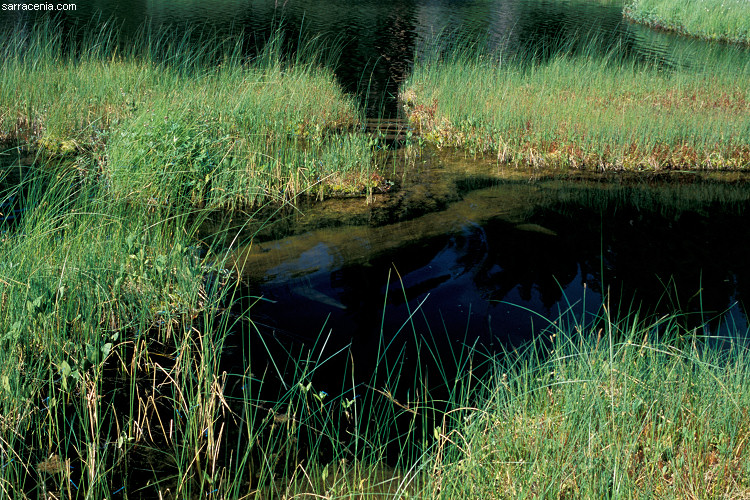
Dangerous floating mat:
Let me tell you a little more about the Sphagnum mat at this site. As I said a few pages back, the mat was exceptionally
well developed. As I walked on its surface I could feel it sink slightly as it deformed under my weight, but there
was no sense that I might plunge through. As such, I went about my work with aplomb; even casual carelessness! But as
I reached the edge of the
mat, on the edge towards the open water of the lake, I was shocked at what I saw. The lake water was wondrously clear
(and not heavily tinged with tannins), so standing at the edge of the mat and peering downwards I could see that the water
was oh-so-very deep. Despite the clarity of the water,
the bottom of the lake was so distant that submerged
rocks and sunken logs were merely dark shadows in the deep. I could also see the underwater structure of
the mat edge: it was perfectly delineated by vertical walls of peat several feet in height, all
subaquatic!
In the image above, you can see
fingers of the mat extending over the water's surface, and down in the inky depths are submerged logs and, I presume, the
slowly decaying corpses of those who had trodden the surface with aplomb and casual carelessness.
It really was bracing, looking down into the holes at the edge of the mat, wondering just how deep the leech-filled waters
were. And as if sent by Providence, along came the two graduate students I mentioned earlier.
Chatting with them about the mat and the
leeches, I learned that one was carrying a depth gauge (she was an aspiring paleobotanist who was surveying lakes
that had large
peat accumulations). She measured the depth of the water at the edge of the
Sphagnum mat as 6.7 meters! For those of you who are metric-challenged, this is about 22 feet!
Dang, this water is deep! Don't mess with false lake bottoms, I'm warning you!